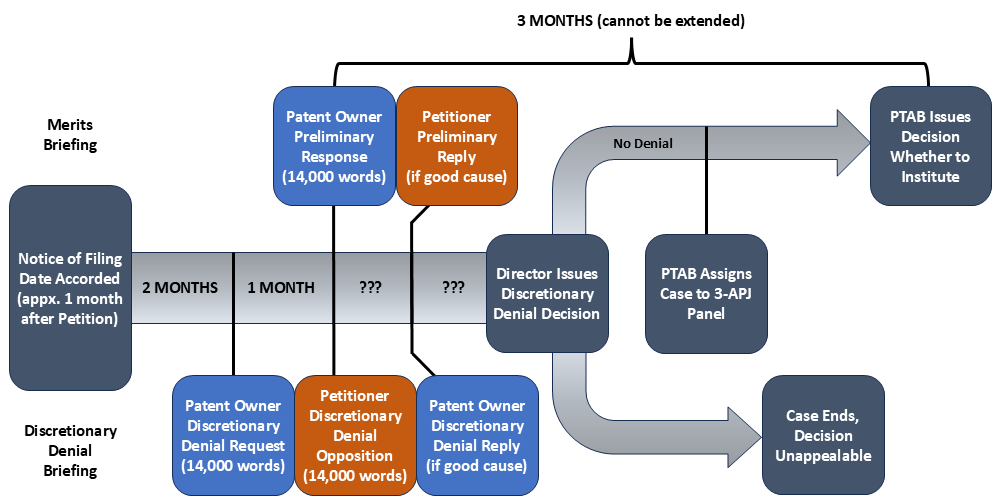New Interim Process for Patent Trial and Appeal Board Workload Management
The USPTO has fundamentally altered the PTAB institution decision framework through a March 26, 2025, memorandum from Acting Director Coke Morgan Stewart. In a significant departure from existing practice, the memorandum details the Acting Director’s decision to bifurcate discretionary denial determinations from merits-based reviews. This update analyzes the procedural changes and their implications for PTAB practice.
Understanding Discretionary Denial Authority
The Director of the USPTO has long claimed broad statutory authority under 35 U.S.C. §§ 314(a) and 324(a) to deny institution of IPR and PGR proceedings, even when petitioners meet the threshold showing of unpatentability. The US Supreme Court confirmed in United States v. Arthrex (2021) that “Congress has committed the decision to institute inter partes review to the Director’s unreviewable discretion.” This “discretionary denial” power allows the USPTO to decline review for reasons unrelated to the technical merits of the petition — such as parallel district court litigation timing (so-called Fintiv denials), serial petitioning (General Plastic denials), or prior consideration of the same arguments (Advanced Bionics/325(d) denials).
Historically, this discretionary denial authority has been delegated to the three-judge PTAB panel assigned to each petition, which considered both discretionary and merits-based grounds simultaneously when evaluating institution. The Acting Director’s new memorandum fundamentally changes this approach by removing responsibility for decisions on discretionary denial from the PTAB’s panels and vesting it in the Director herself.
The Complex Pre-Institution Timeline Under the New Process
The new bifurcated approach creates a complex pre-institution process with distinct phases for discretionary and merits considerations:

Notably, the statutory three-month clock for the PTAB’s institution decision begins running at the Preliminary Response filing date. This creates an unprecedented scheduling challenge. If the Director must personally decide discretionary issues for more than a hundred petitions monthly, the discretionary review process could take considerable time, even with the assistance of several APJs. This delay in addressing the petition’s merits will likely consume a significant portion of the statutory window between the Petitioner’s discretionary denial brief and the institution decision, leaving the merits panel with limited time to evaluate the case if the Director decides against discretionary denial. (If the Director grants Patent Owner a discretionary denial reply, this time period for evaluation on the merits is shortened even further.) The memorandum provides no guidance on how the PTAB will manage these overlapping timelines or what will happen if the Director’s discretionary review extends too close to the statutory institution deadline, delaying assignment of a case to a merits panel.
Workload Management: Justification and Context
The memorandum explicitly cites “current workload needs of the PTAB” as the driving force behind these procedural changes, with a stated aim to “improve PTAB efficiency, maintain PTAB capacity to conduct AIA proceedings, reduce pendency in ex parte appeals, and promote consistent application of discretionary considerations.” This workload concern appears directly connected to recent federal workforce policies affecting the USPTO.
The Trump administration’s “fork-in-the-road” deferred resignation program, government-wide hiring freeze, and return-to-office mandates have anecdotally led to significant attrition among Administrative Patent Judges (APJs). With approximately a dozen APJs taking the “fork” offer, and others announcing early retirement, a reasonable estimate is that the PTAB has already lost approximately 10 percent of its judge corps in recent months. While the USPTO memorandum characterizes this situation as “temporary,” it is unclear how the situation is likely to improve in the near term. In fact, PTAB Chief Judge Scott Boalick recently notified his organization to prepare for a reduction-in-force (RIF).
However, the Acting Director’s memorandum implementing an entirely new process for evaluating discretionary denials raises questions about how workload benefits will be realized by the PTAB. Realistically, more than three APJs will need to “consult” with the Director to keep pace with the 100-plus petitions filed each month, as it is reasonable to assume that patent owners will seek discretionary denial in almost every, if not every, case. Diverting these APJ resources to a separate discretionary denial process does not appear likely to free up resources to consider the merits of IPR/PGR challenges; rather, it merely moves those resources under the Director’s direct control. The only way the bifurcated process is likely to result in a significant reduction of the PTAB’s workload will be if the new procedure leads to an increase in discretionary denials. Thus, despite the memo’s workload justification, its practical effect will likely be to increase discretionary denials, which will, in turn, reduce the overall institution rate for petitions.
New Discretionary Considerations: Expanded Scope With Little Precedent
The Director’s memorandum also substantially expands the factors that may justify discretionary denial far beyond the established framework. The factors include:
- Whether any forum has previously adjudicated the patent claims’ validity.
- Post-issuance changes in law or precedent affecting patentability.
- The strength of the unpatentability challenge.
- The extent of the petition’s reliance on expert testimony.
- “Settled expectations” of the parties, including how long the patent has been in force.
- Compelling economic, public health, or national security interests.
- The PTAB’s workload capacity and ability to meet statutory deadlines.
Unlike the Fintiv, General Plastic, and Advanced Bionics discretionary denial considerations — which developed incrementally through PTAB precedent, with case law citations and regulatory justifications — the new factors appear to be novel and lack traditional statutory or regulatory foundation. This immediate expansion of discretionary considerations with little accompanying commentary leaves practitioners with extremely limited guidance on how these factors will be applied or weighed in practice.
Several considerations may be particularly likely to lead to increased uncertainty. The “settled expectations” factor suggests older patents might be immune from PTAB review based on their age, but the memorandum provides no guidance as to how old a patent needs to be before its validity cannot be subject to IPR. Similarly, the prospect of discretionarily denying a petition because of “the extent of reliance on expert testimony” may make petitioners question whether a detailed, comprehensive expert declaration may counterintuitively lead to denial of the petition. And from an efficiency standpoint, the “strength of the challenge” consideration will require the Director to examine the merits of each petition’s validity grounds, an evaluation which the PTAB merits panel will have to later undertake as well — a potentially inefficient duplication of effort, now built into the process.
Most concerning for stakeholders may be the explicit acknowledgment that the Director may deny institution based solely on PTAB “workload capacity.” If the USPTO begins denying meritorious challenges purely for administrative convenience, this factor risks transforming discretionary denial from a policy-based consideration into a resource management tool. It also may severely diminish the predictability of the Director’s discretionary denial evaluation — it is difficult to see how a prospective petitioner could adequately anticipate the workload demands of the PTAB three to six months in the future, when the Director will be deciding whether to deny a particular petition due to workload capacity.
Immediate Application and Strategic Considerations
The procedures outlined in the Acting Director’s memorandum apply to all IPR and PGR proceedings where the patent owner preliminary response deadline has not yet passed. For cases where the discretionary denial briefing timeline has already elapsed, patent owners have a one-month window from the memo’s date to submit discretionary denial arguments. Practitioners, therefore, must immediately adapt to these changes on behalf of their clients.
Patent owners may wish to capitalize on this shift by attempting creative new discretionary denial arguments that test the limits of the new factors announced by the Director, particularly emphasizing patent age and PTAB workload concerns. Petitioners should carefully evaluate the extent of their reliance on expert testimony and consider challenging the application of any new discretionary denial justifications that are applied without notice. All practitioners should closely monitor early decisions under this framework to identify how the Director weighs these new factors and consider whether alternative forums may now provide more predictable paths for patent challenges.
Finally, it is critical to recognize that decisions whether to institute an IPR or PGR are unappealable, and thus parties will have no opportunity to seek review of the Director’s decision whether to discretionarily deny a petition. Moreover, appellate courts will not have the ability to provide direct feedback to the USPTO on the new discretionary denial doctrines announced in the memorandum. Given that the new bifurcated process and considerations announced by the Acting Director were not the product of traditional notice-and-comment rulemaking as required by the Administrative Procedure Act, this means that the sole opportunity for stakeholders to have a voice in these rapidly developing doctrines is through case-specific briefing during pending IPR or PGR petitions. This context only heightens the importance of strategically developing arguments and counterarguments on discretionary denial under the new briefing process.
While characterized in the memorandum as “temporary,” it is reasonable to expect that these procedures will significantly impact PTAB practice for the foreseeable future. The USPTO has promised a “boardside chat” with PTAB leadership to address implementation questions, which will hopefully provide additional clarity on these sweeping changes. We will continue to monitor the significant changes to the PTAB and provide updates as warranted.




 />i
/>i

